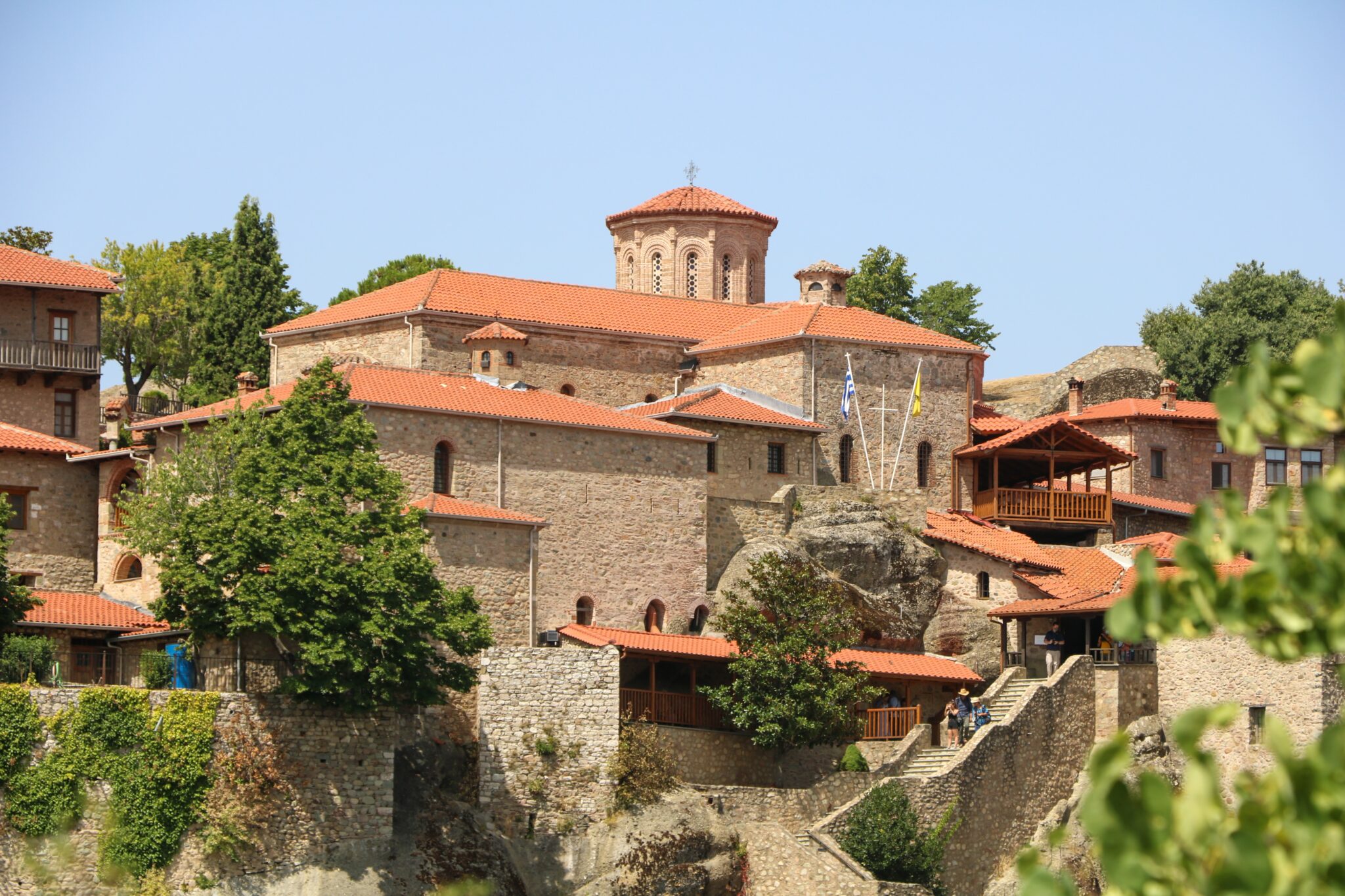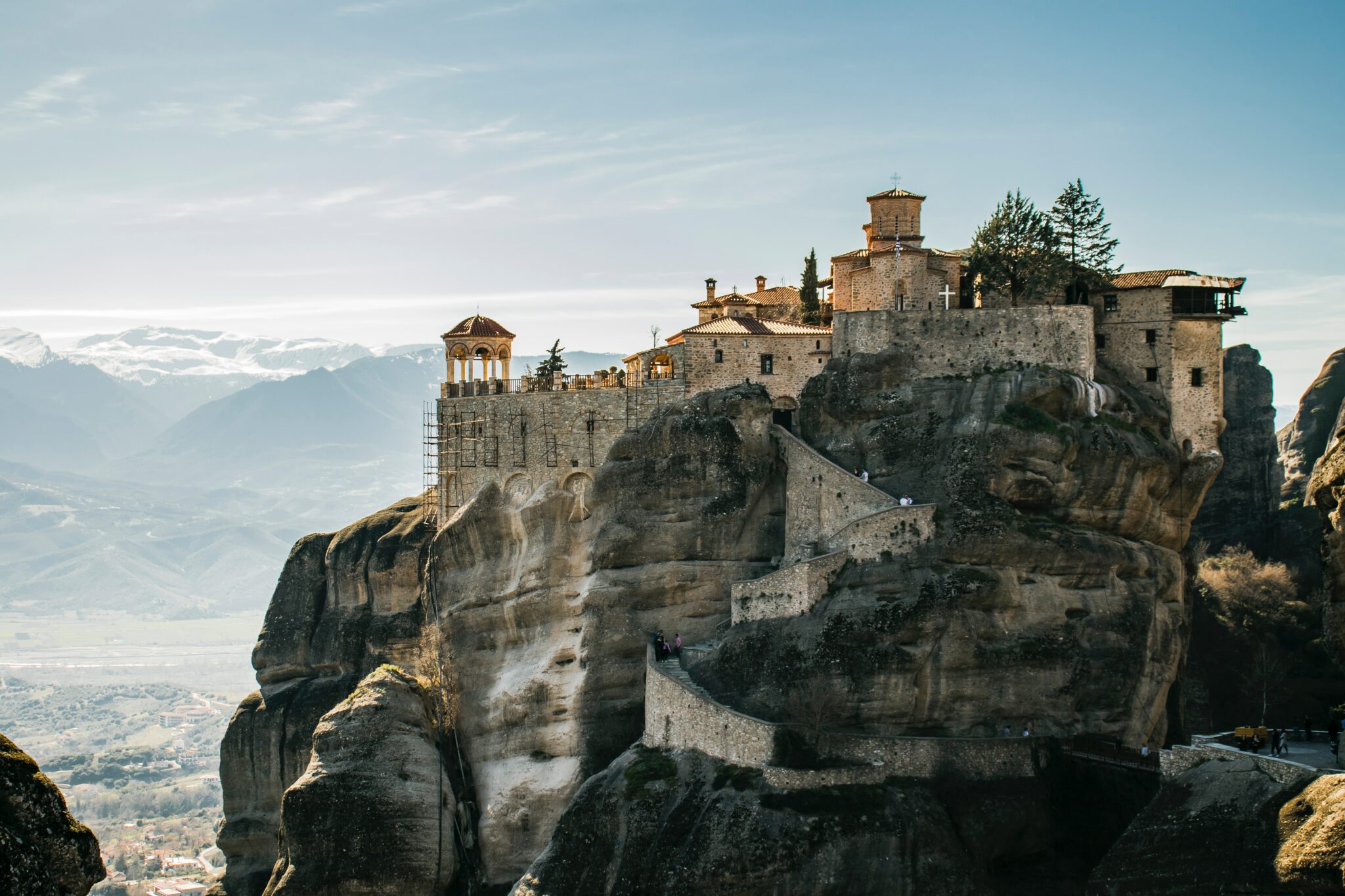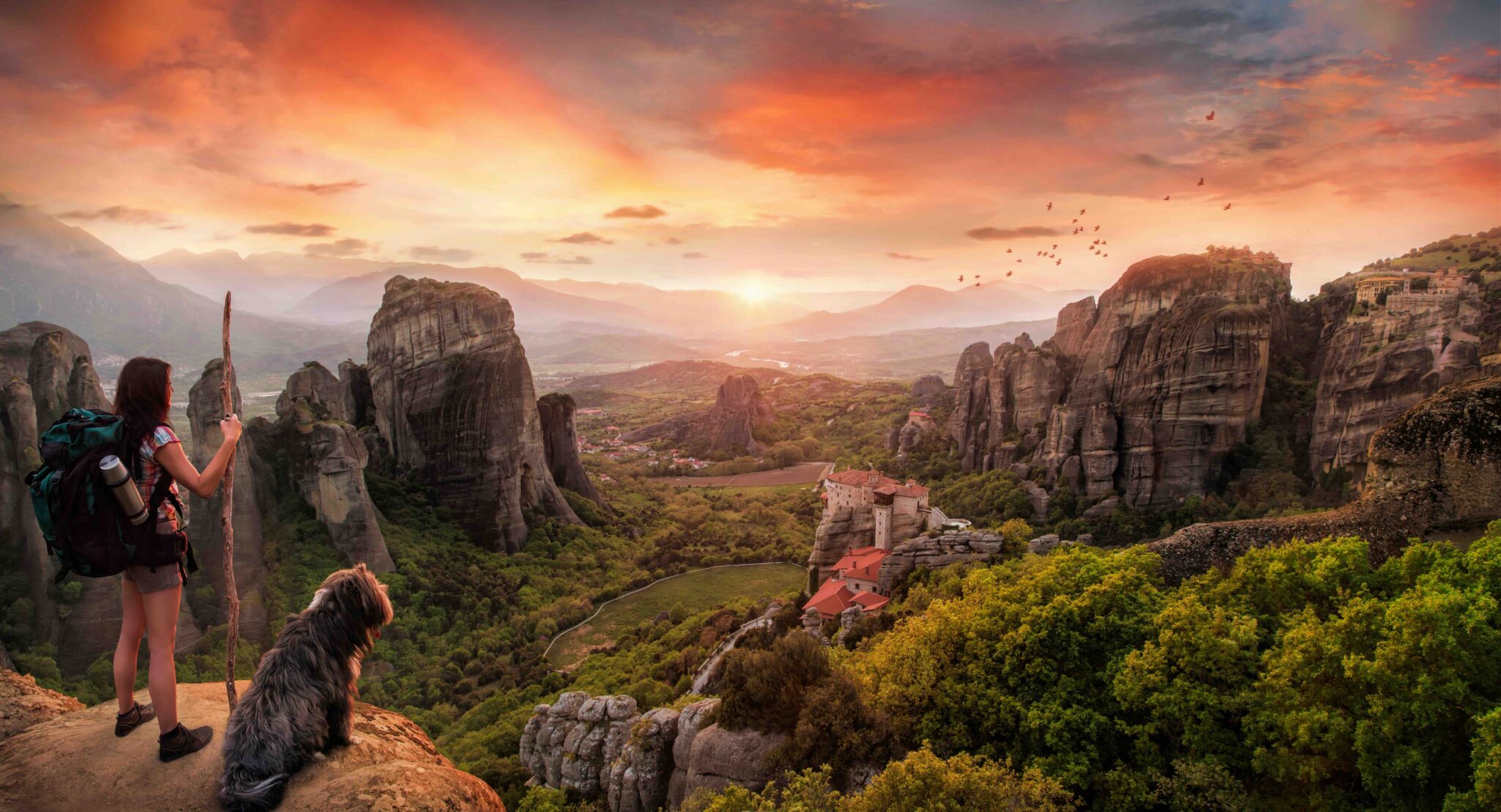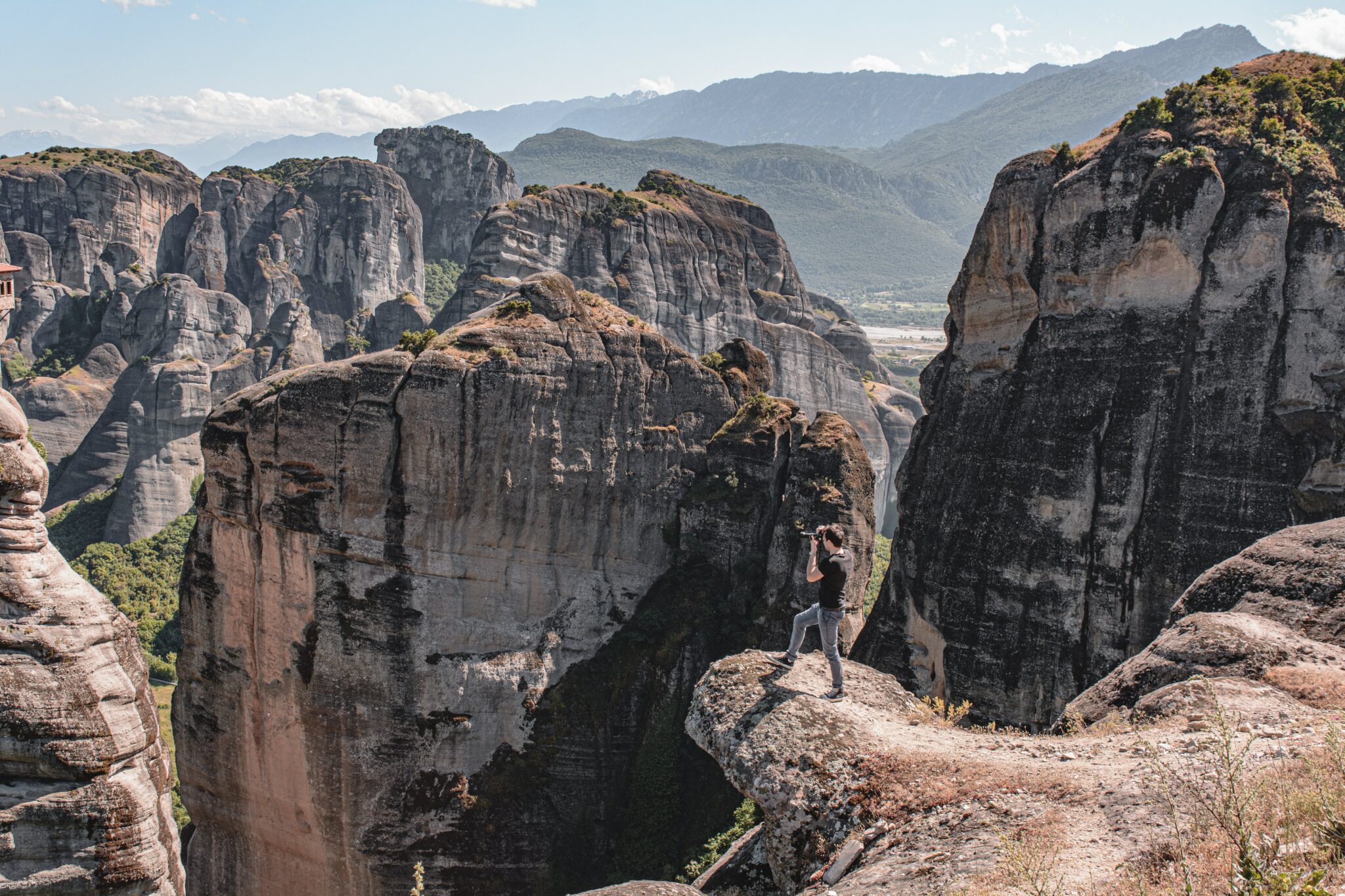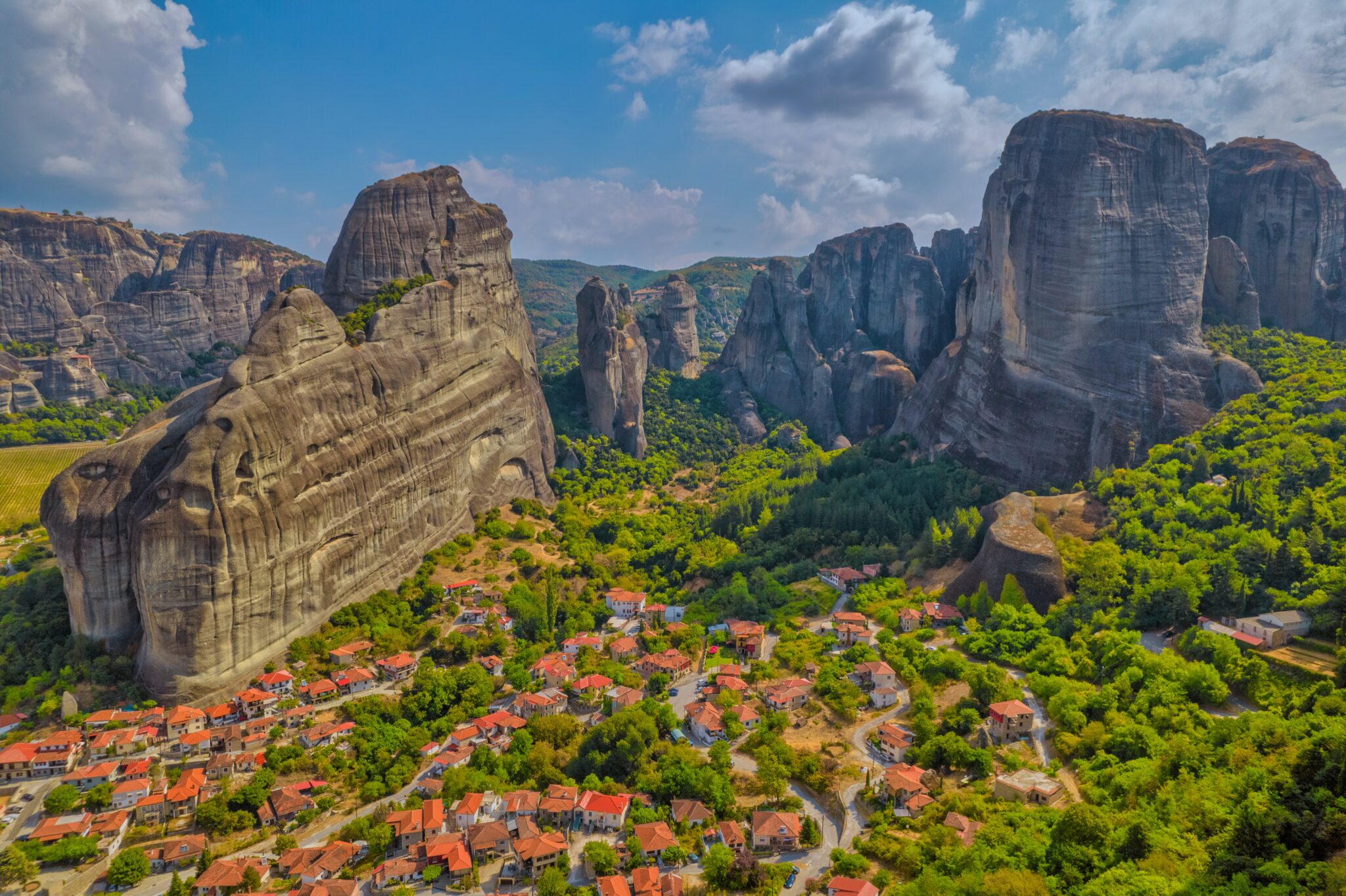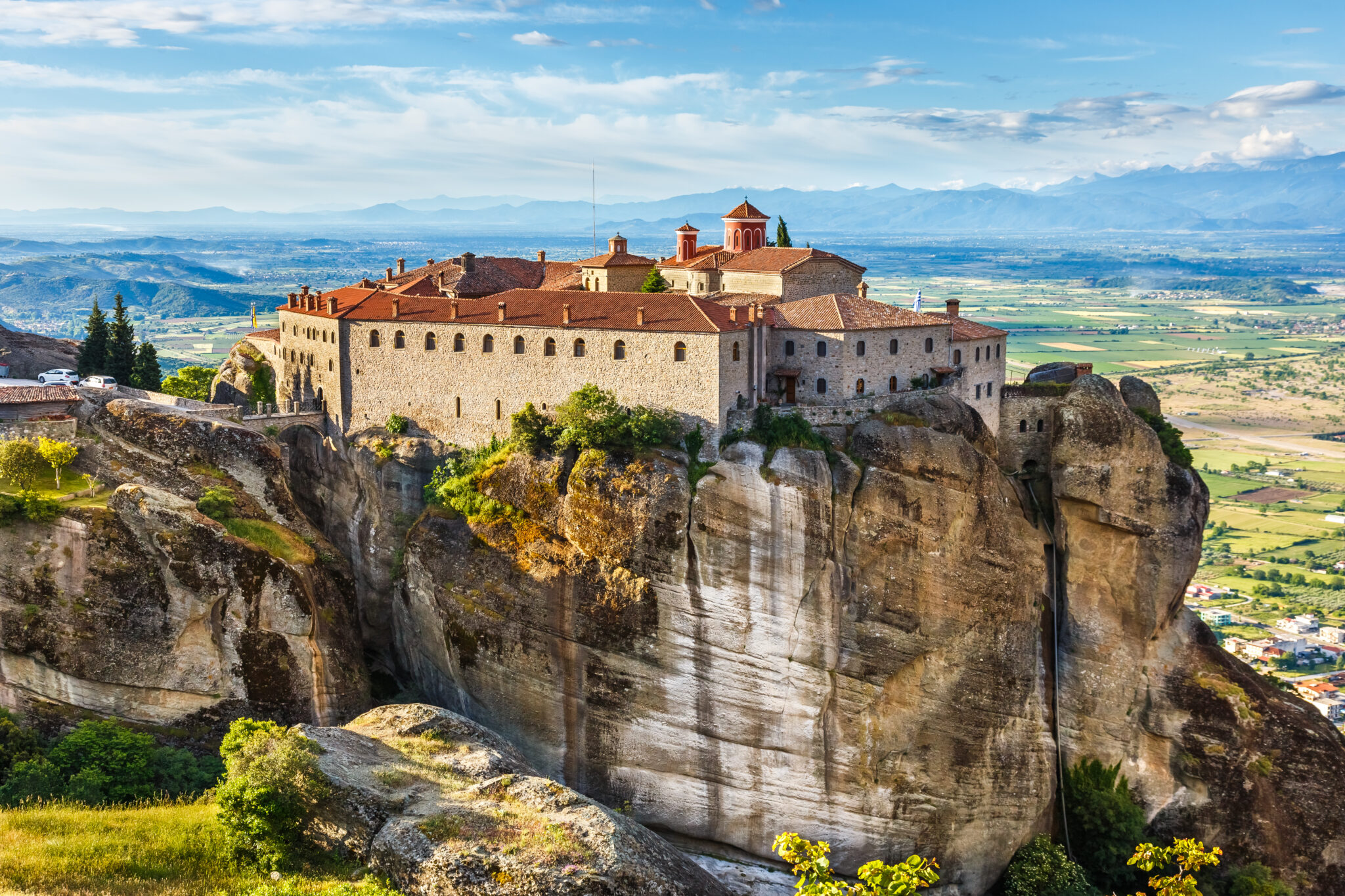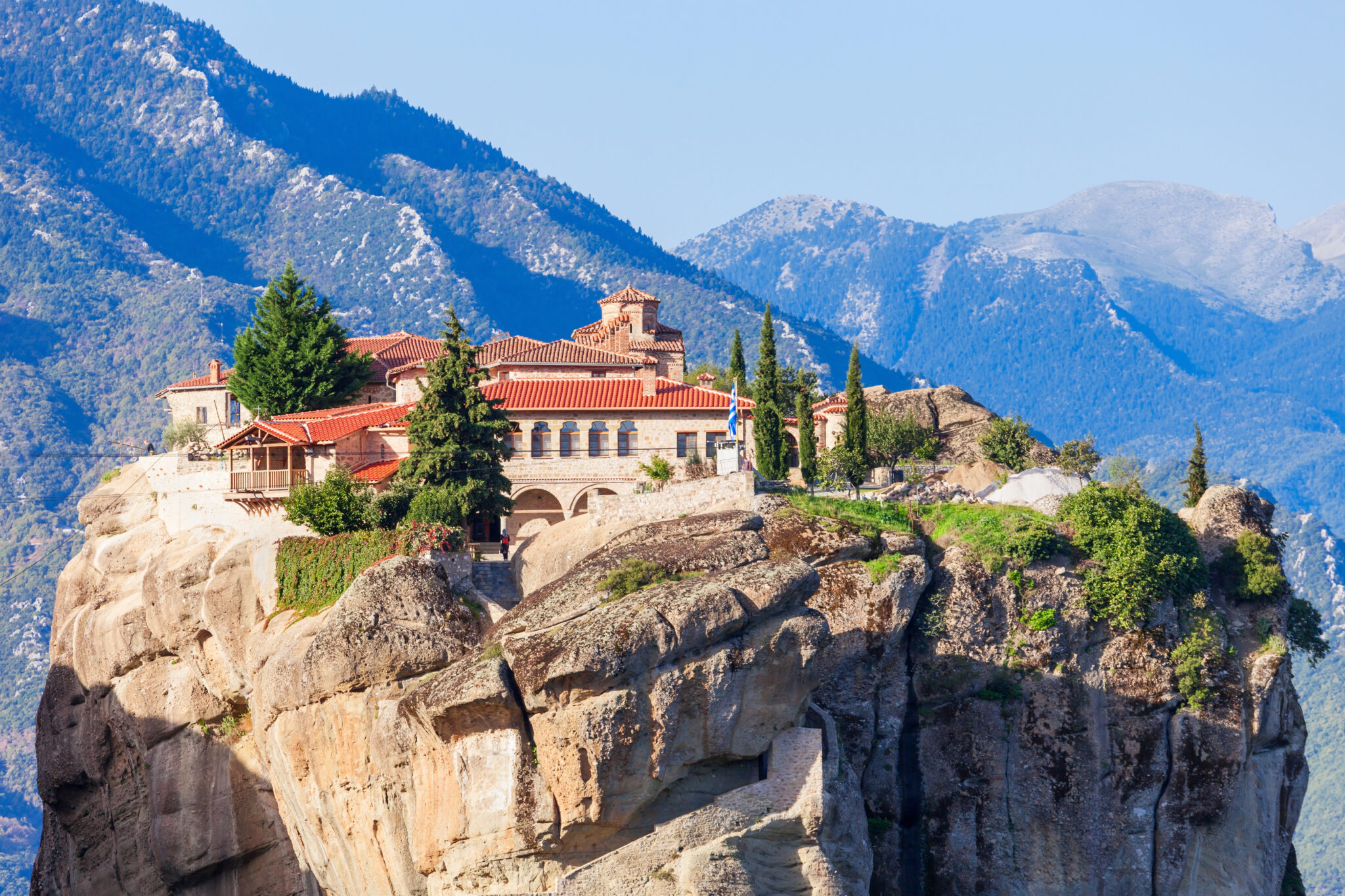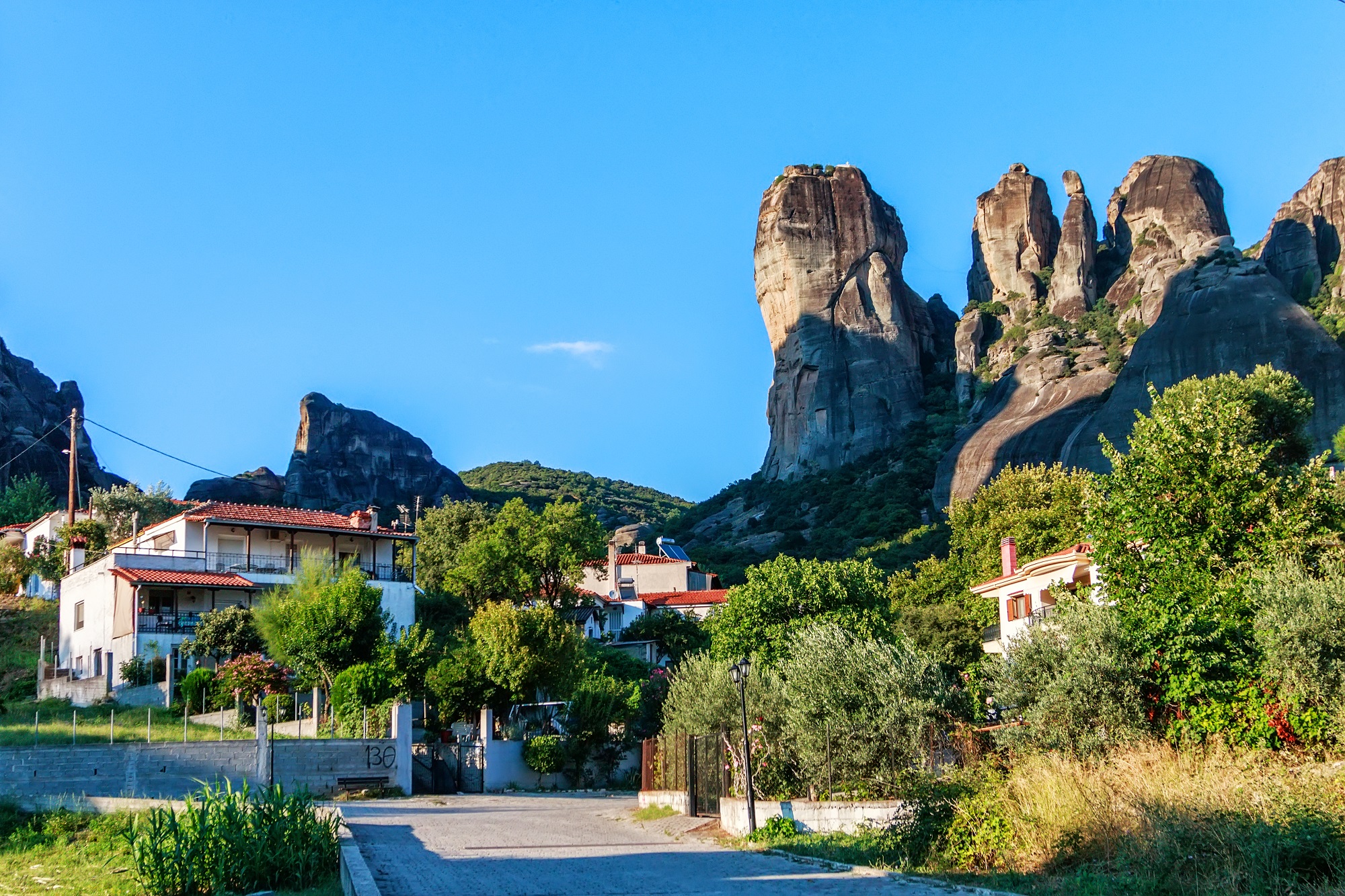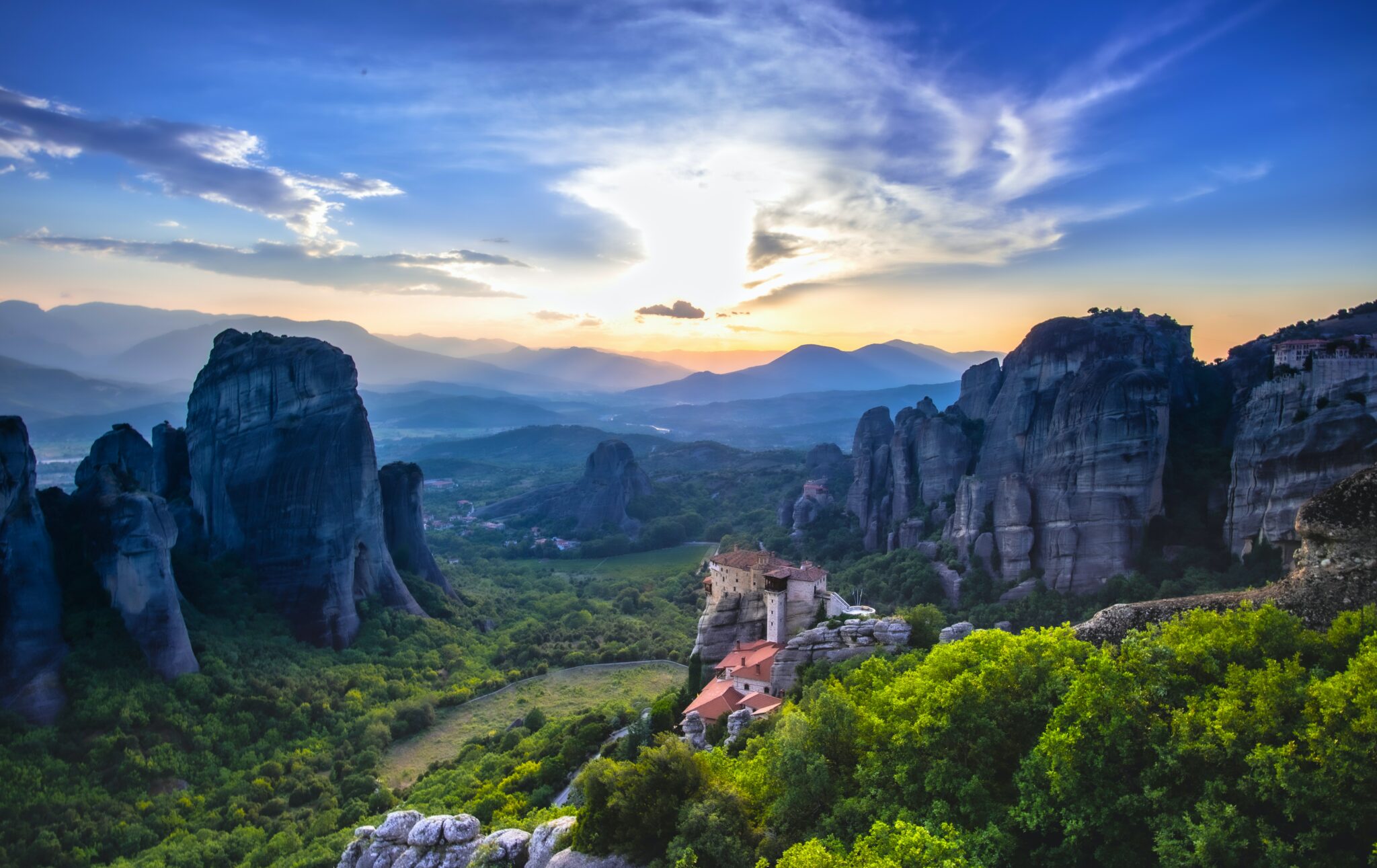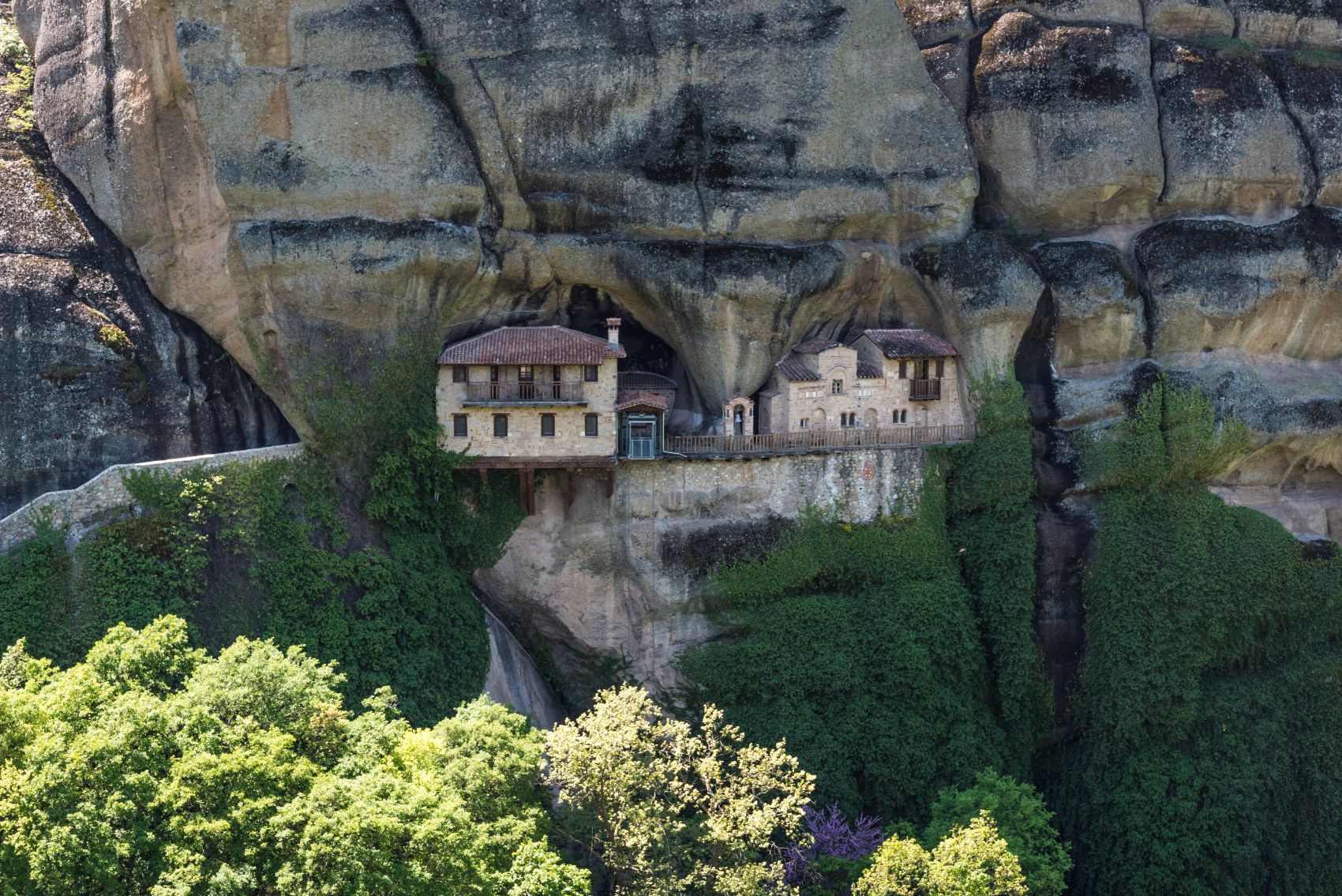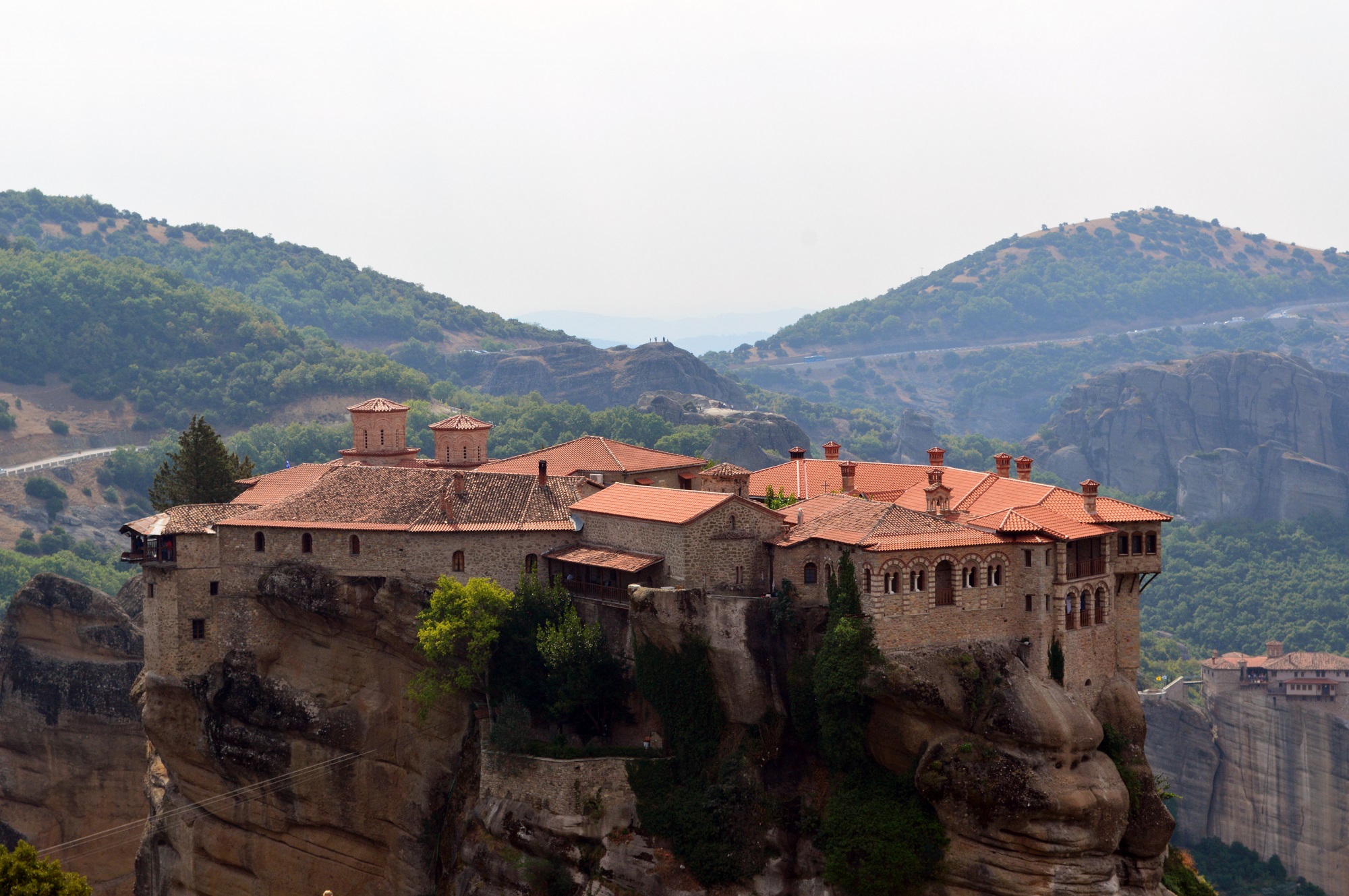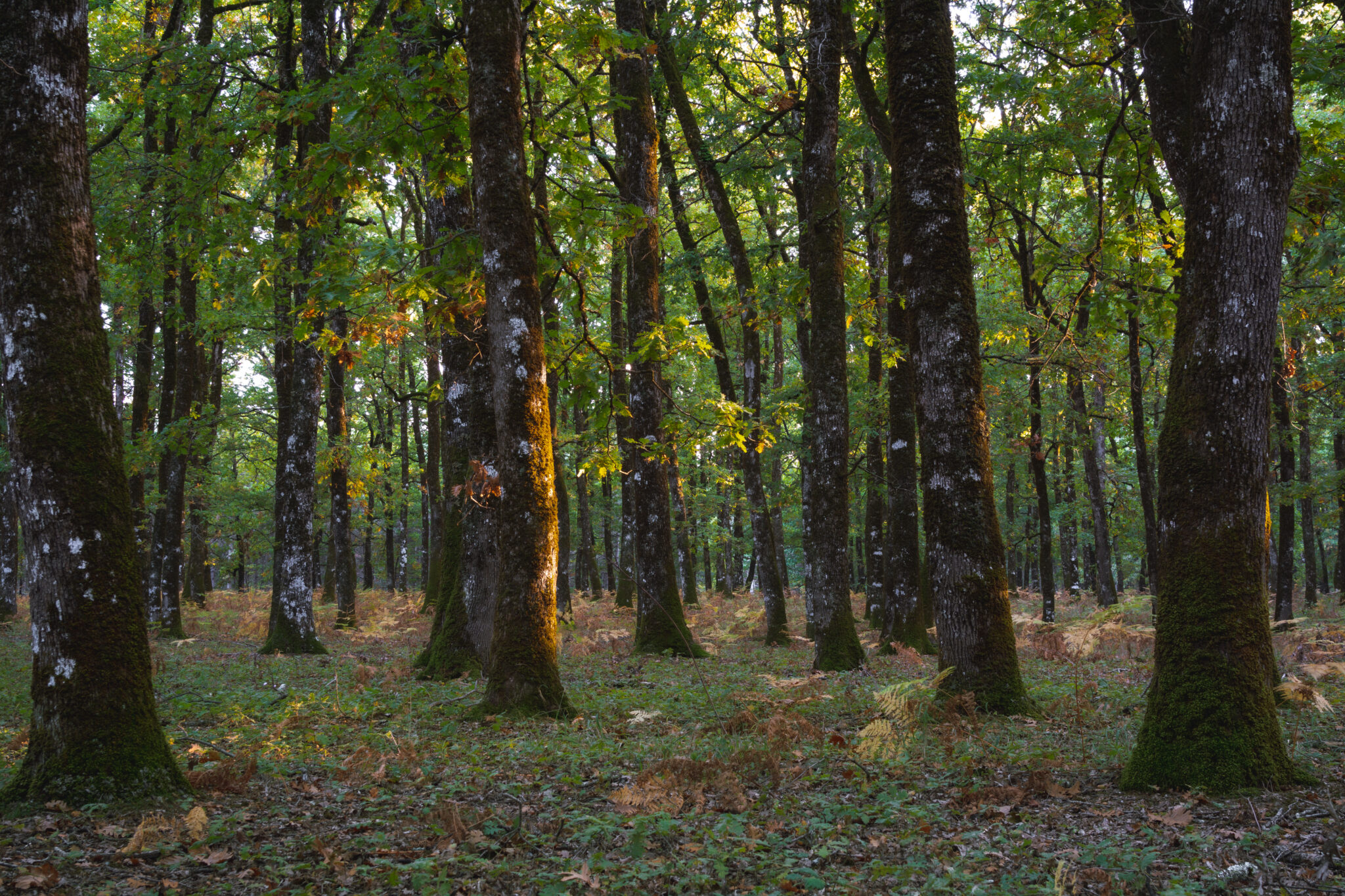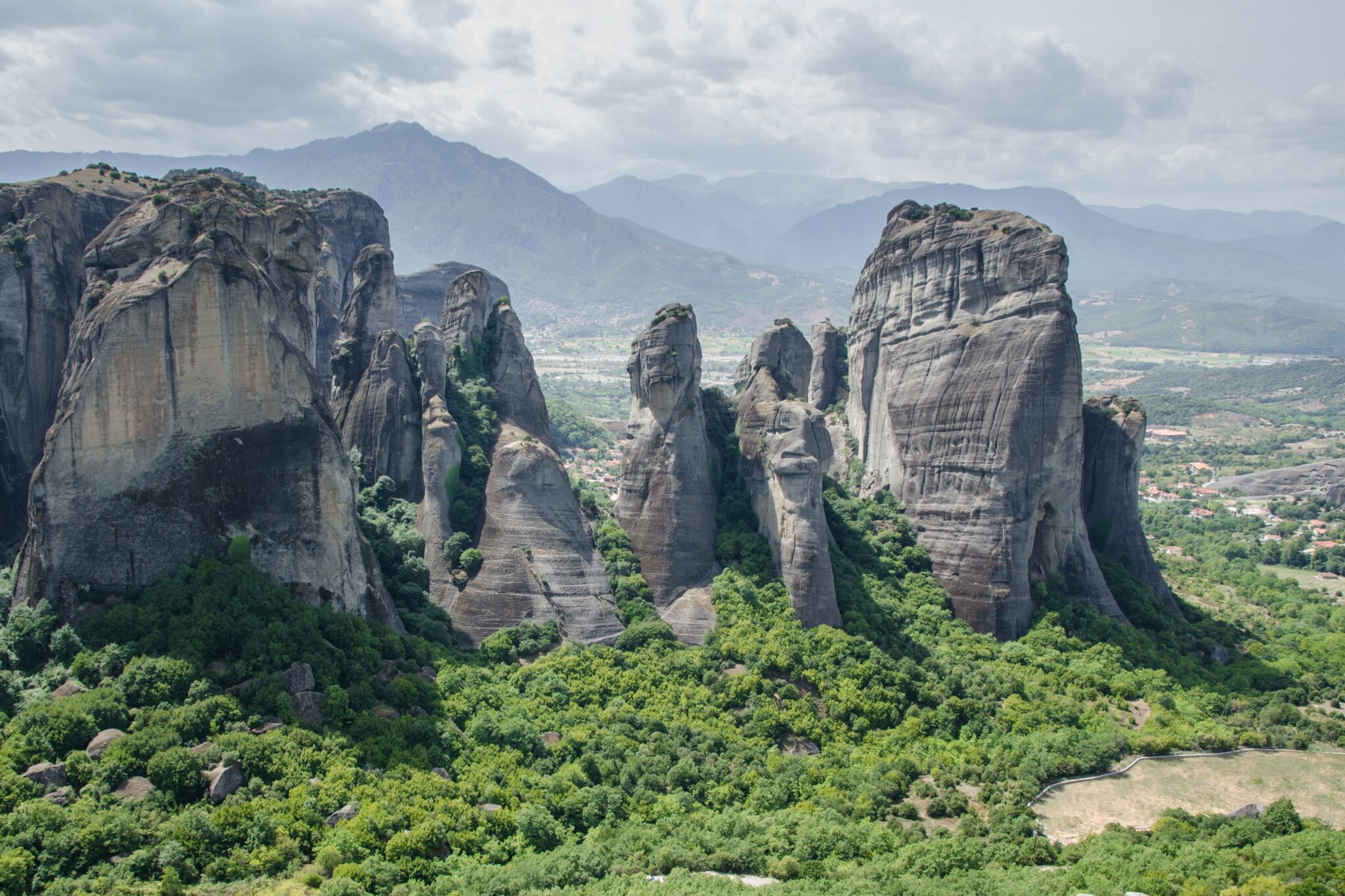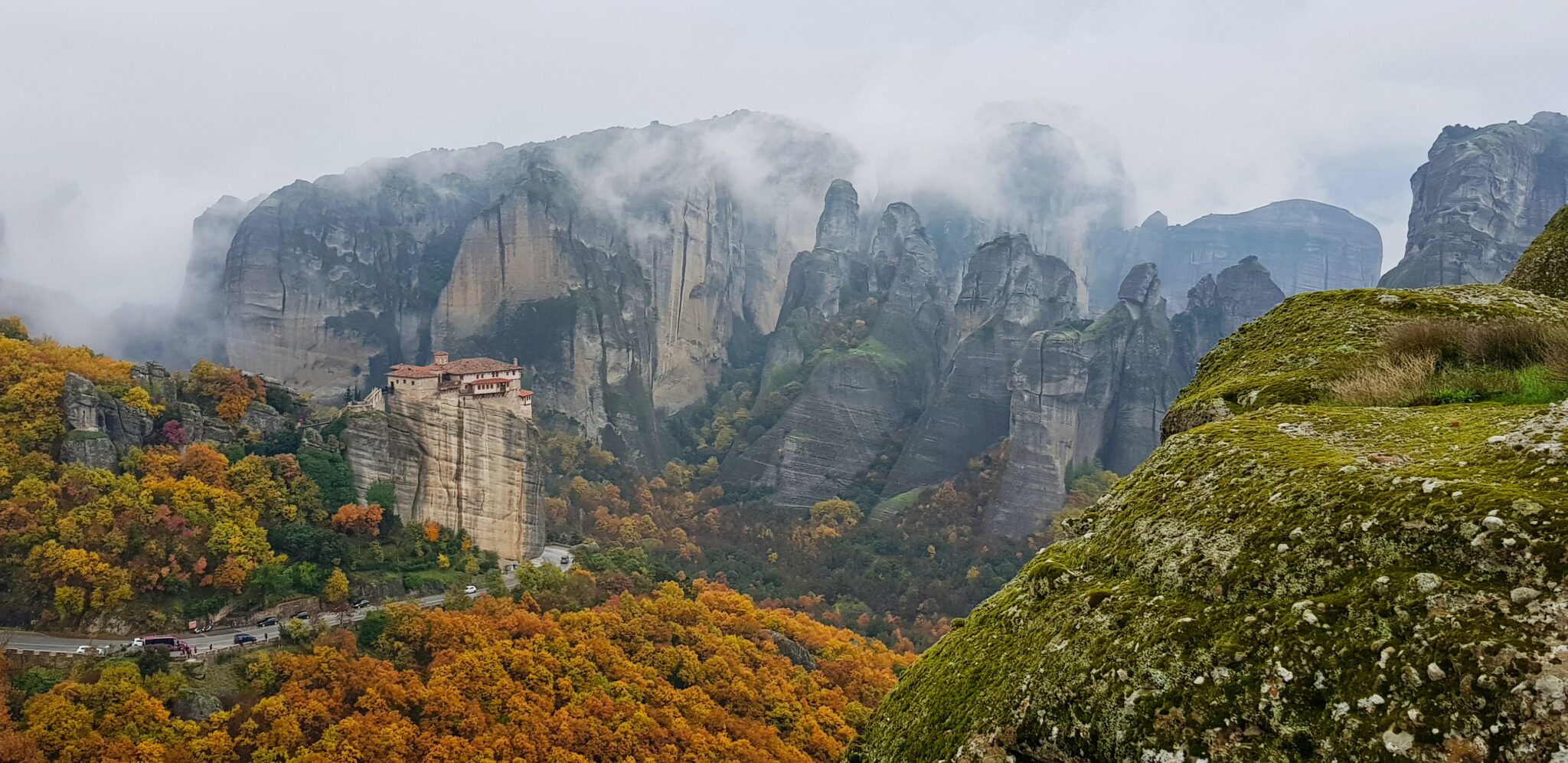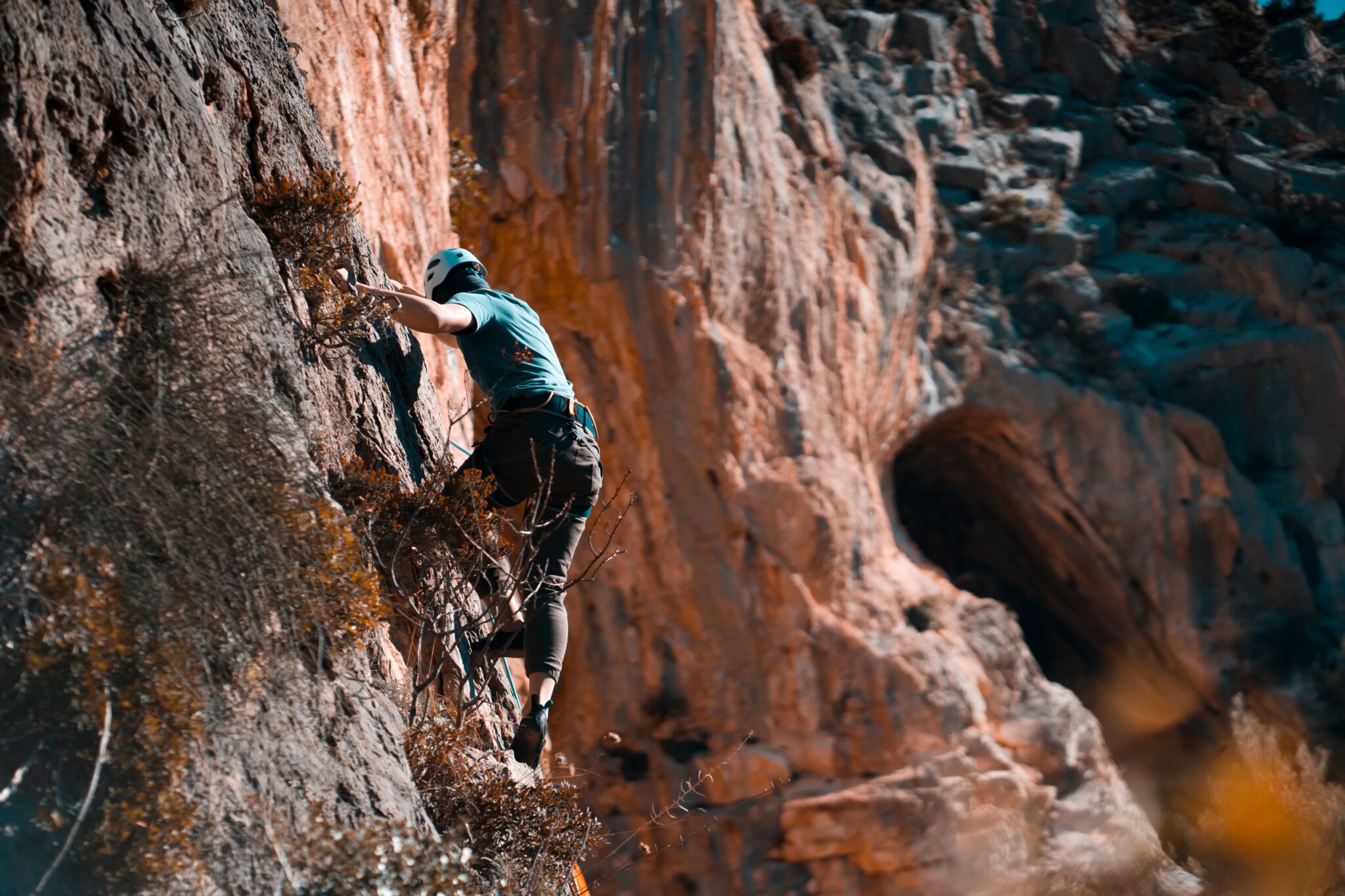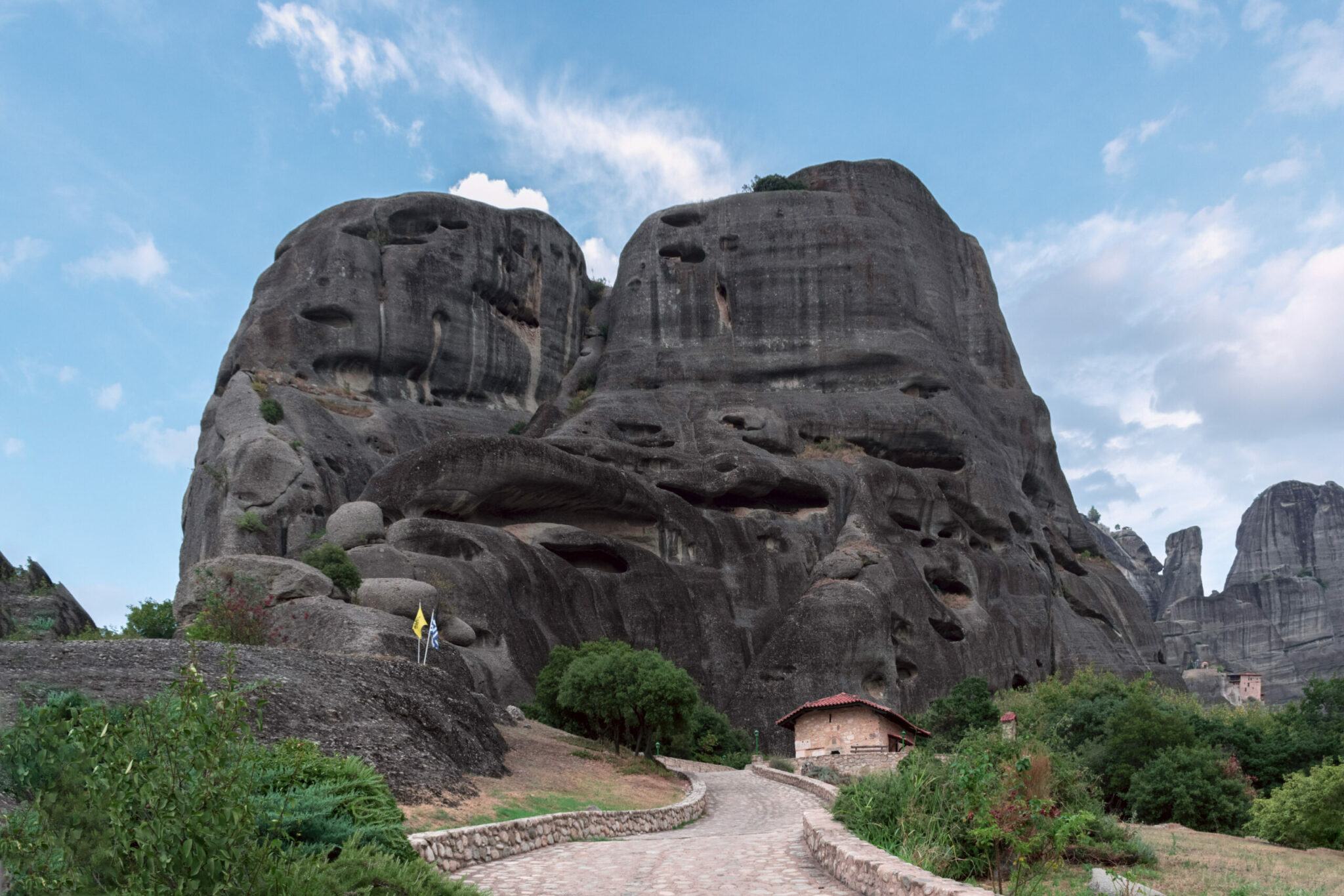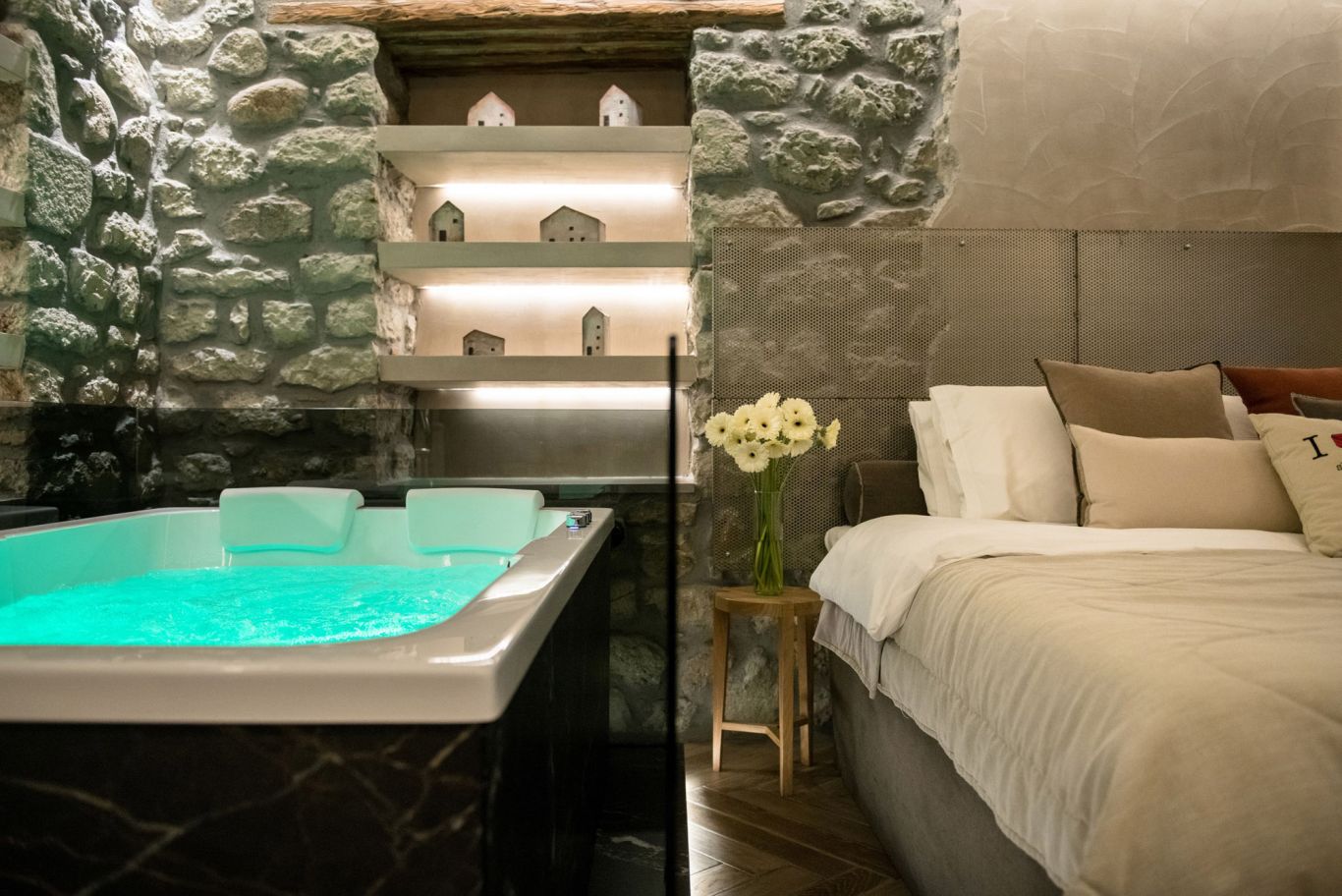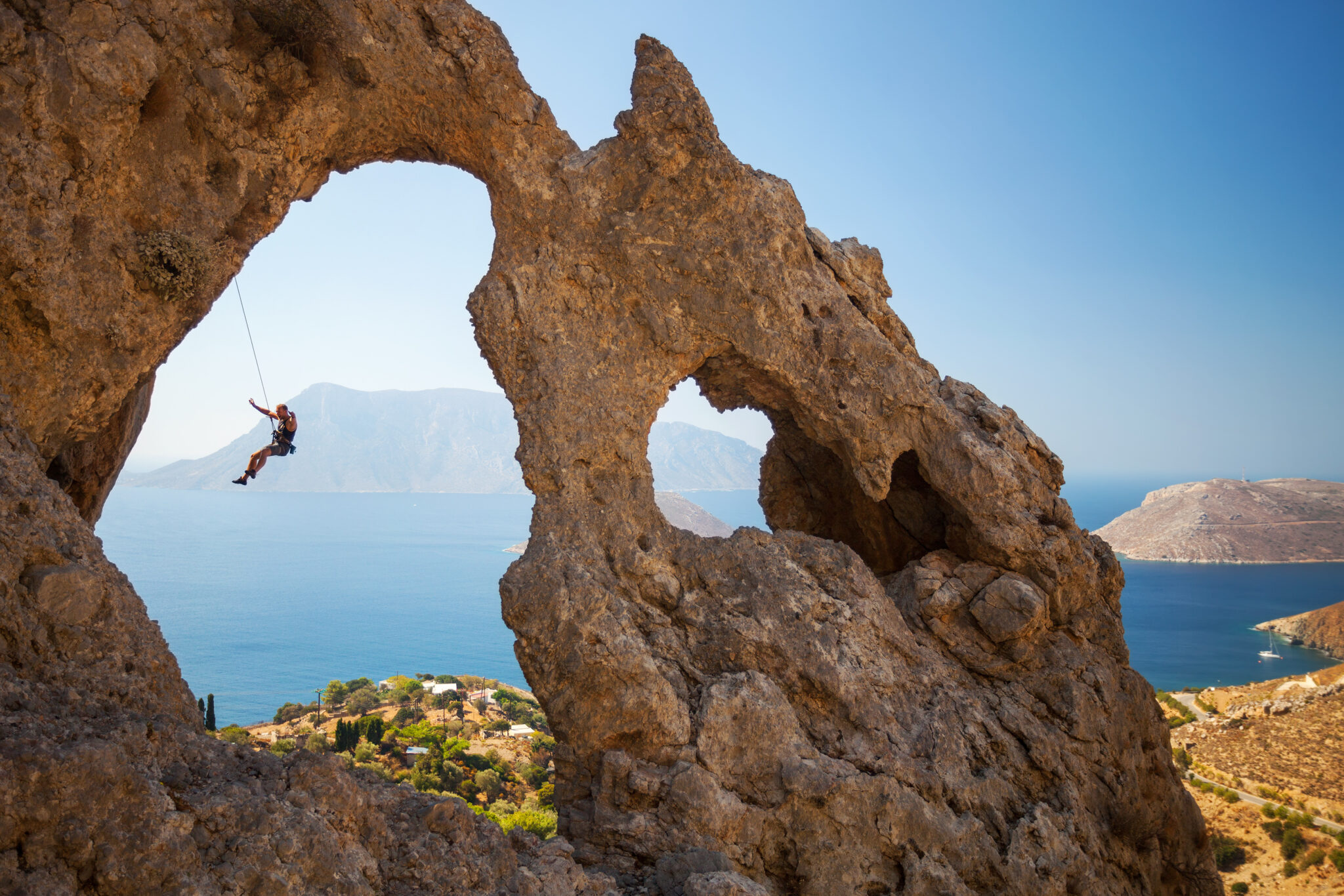Rising from the plains of Thessaly, Meteora stands as a masterpiece of nature’s architecture – a protected sanctuary where towering pillars of stone pierce the Greek sky. Beyond its celebrated monasteries perched like eagles’ nests on weathered cliffs, this UNESCO-protected landscape harbors secrets known only to those who venture on foot. Here, the ancient valleys of Peneus and Lithaios rivers carve through forests of plane and oak trees, while hidden paths wind through a wilderness where rare flora flourishes and protected species find refuge.
This guide opens the door to Meteora’s maze of trails, each offering its own revelation of this sacred landscape. Whether you seek the whispers of medieval monks or the call of wild peaks, these paths will lead you through one of Europe’s most extraordinary convergences of natural wonder and human devotion.
Meteora’s Environment
The significant flora here includes endemic species such as the Kalambaka Centaury (Centaurea kalambakensis), Milky Centaury (Centaurea lactiflora), and the protected Cretan Anthem (Anthemis cretica). The area is crucial for the breeding of birdlife and hosts populations of protected species such as the Egyptian vulture (Neophron percnopterus), owls, eagles, and other predatory birds. In the Meteora region, otters (Lutra lutra), wolves, bats (myotis and rhinolophus), turtles, dormice, tree frogs, pipistrelles, alpine newts, snakes, and lizards, among others, can also be found.
However, this habitat is threatened by the deforestation of oak forests, the expansion of the road network, illegal hunting, overgrazing, light pollution from giant spotlights, and the mass tourism that the monasteries attract.
Hiking High & Low
Whether you are a novice or a seasoned hiker, there is a path for everyone. The trails lead through lush forests, past babbling brooks, and over rocky terrain, taking you to ancient monasteries perched high atop the cliffs. You will also come across steep cliffs that offer a robust challenge to adrenaline junkies looking to push their limits.
As you hike, you’ll be rewarded with stunning vistas of the surrounding countryside, including distant mountains, valleys, and the sky. The natural beauty of this region is unrivaled, and it has inspired artists, writers, and photographers for centuries.
It’s a real shame that there is absolutely no signage on the paths of Meteora. This area could be the top destination for cultural hiking in Greece as it combines a unique natural landscape with impressive cultural wealth (the monasteries). The TERRAIN hiking map accurately captures all the well-trodden paths in the Meteora area, but you’ll need a good pedometer app on your phone to calculate distances, as well as a compass and a good sense of direction to avoid getting lost. Make sure you have water with you, and some nourishing power snacks.
Wherever you walk in Meteora, the landscape’s beauty is astounding, but we recommend these seven routes, which offer the best tried and tested hiking experience in this area.
The Best Trails
01
Kastraki – Rock of Holy Spirit – Varlaam Monastery – Transfiguration of the Saviour Monastery
Total distance: 2.4 km. Time: 1 hour and 10 minutes
A scenic and relatively easy hiking trail that will take you to two of the most beautiful monasteries in Meteora. It starts from the eastern edge of the village, at the end of the cobbled road behind the Geological Formations Museum. The path rises upwards on the vertical southern side of the impressive rock called Holy Spirit. Built on top of it is one of the oldest hermitages in Meteora, and from below the rock, it’s impossible to conceive how the monks managed to climb up there. But after 500 metres (from the start of the trail), you’ll see the branch of the trail that leads up to the top, where you’ll be rewarded with a magnificent view. Note that this part has many exposed and dangerous points and requires a lot of attention.
Once you cross the main asphalt road, you’ll enter the most beautiful part of the trail, a stone path between the rocks of Meteora, surrounded by dense vegetation. About 400 meters after the road, you’ll see the intersection of the path that climbs to the right (east) and after 300 meters leads to Varlaam Monastery. The main path continues north and climbs between the openings of the majestic rocks to end after 200 meters at the Transfiguration of the Saviour Monastery.
02
Kalambaka-Agiou Stefanou Monastery
Total distance: 4 km. Hiking time: 2 hours
At the eastern entrance of Kalambaka, follow the central Trikalon road and immediately after the Divani Hotel, turn right onto Zacharias Pseira Street (northeast) until its end. From there, follow the dirt road towards the east. At approximately 1200 meters from the Trikalon road, you’ll see the hiking trail on your left, ascending towards the north. After 400 meters, you’ll reach the deserted chapel of Analipsi. Continue northwards along the dirt road, and after 50 metres from the chapel, turn left onto the hiking trail.
This section of the hiking trail, leading to Agiou Stefanou Monastery, is incredibly beautiful, especially in autumn, as it passes through a dense oak forest. The trail ends at the back garden of the monastery, where, unfortunately, the nuns have placed a large iron gate that prevents you from entering. Instead, you will have to climb up to the top of Pyrgos Hill, north of the monastery (offering an excellent view from above), and then descend to the monastery’s entrance from the asphalt road.
The three hiking trail sections that continue north of Pyrgos Hill give you the opportunity to continue your hiking adventure on Route 5 towards other monasteries of Meteora. Another good option is to go to the Agia Triada Monastery and follow Route 3 from there to return to Kalambaka.
03
Great Meteoro-Grand Circular Hike
Total distance: 5.9 km. Hiking time: 2 hours and 15 minutes
If you love walking through forests, then this is the most enjoyable hike in Meteora. Starting from the parking lot of Great Meteoro, follow the path that climbs up the rock towards the northeast. After 300 meters, you’ll reach a crossroad in five different directions. Take the one heading eastwards, and halfway through the hike, you’ll come across the charming chapel of Agios Athanasios, a perfect spot to rest and take in the view, just 400 meters off the path.
04
Great Meteoro-Vlachava Monument-Varlaam Monastery Outpost
Total distance: 2.1 km. Hiking time: 35 minutes
This is a wonderful hike along the rocks of Meteora, with stunning views of the thickly wooded forest and the plane-tree-covered bed of the river Tranos Lakkos to the north. With a short detour, you can also visit the abandoned Monastery of Hypapante, the ruins of the Monastery of Agios Dimitrios next to it, as well as the peak of the Ftelia rock with its mesmerizing views.
05
Panagia Kanaliotissa Circular Hike
Total distance: 3.1 km. Time: 1 hour and 10 minutes
Take your vehicle towards the Metochi of the Monastery of Varlaam and about 300m before the monastery, turn right (east) onto the dirt road, all the way to the end. From there, a beautiful circular trail through the dense oak forest will lead you to the stone chapel of Panagia Kanaliotissa. After that, the trail ascends to the forested mountain slope towards the southwest and then follows the stream towards the northwest, until it brings you back to the starting point.
06
Great Meteoron – Small Circular Hike
Total distance: 1 km. Time: 20 minutes
A short and very easy hike – more of a stroll – that will give you a great idea of the magnificent nature of the Meteora. You will walk through a small section of the oak forest, hike on top of a rocky peak, enjoy a breathtaking view towards the forests and streams to the north, see monasteries from above, all within a distance of a little over 1,000 meters.
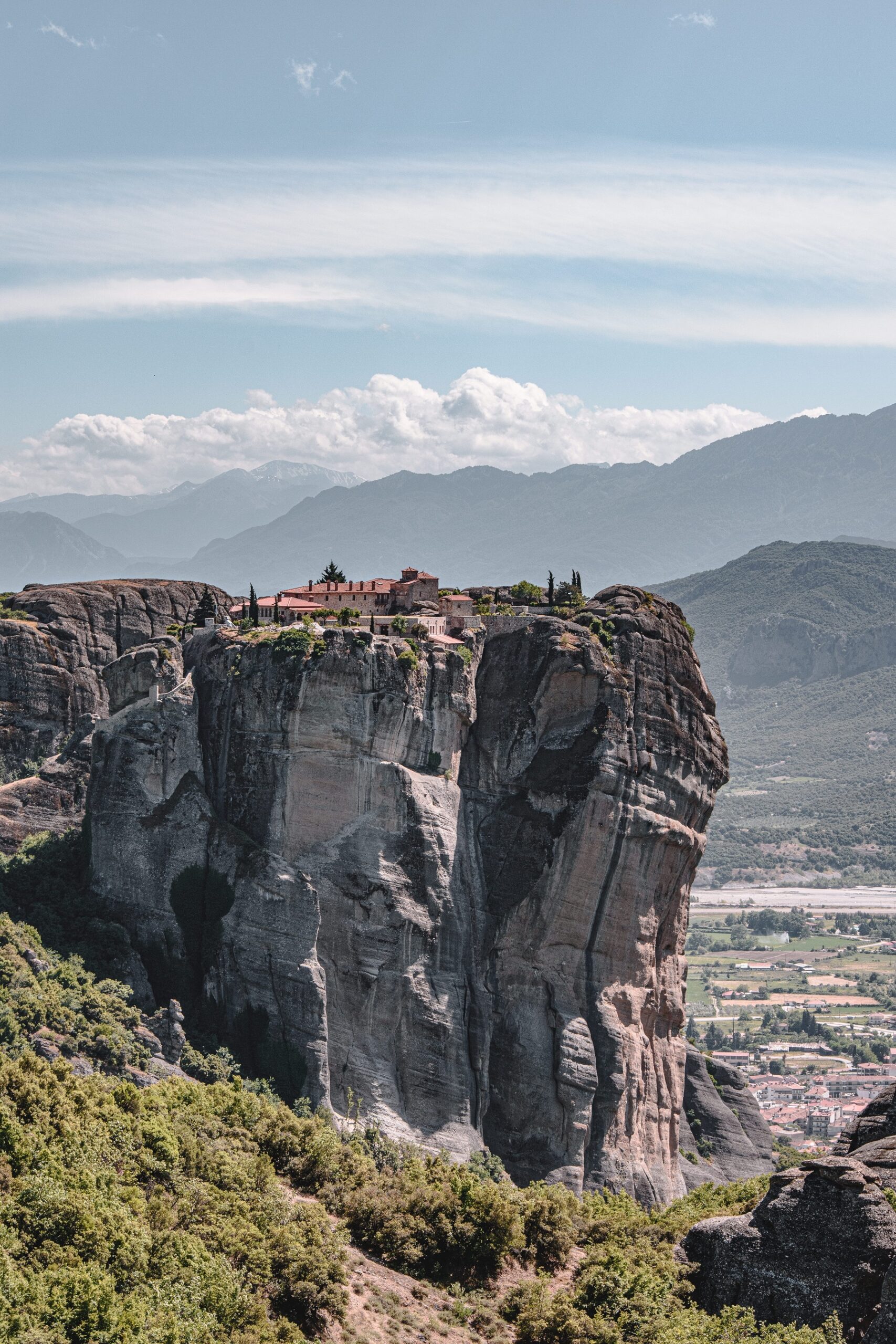
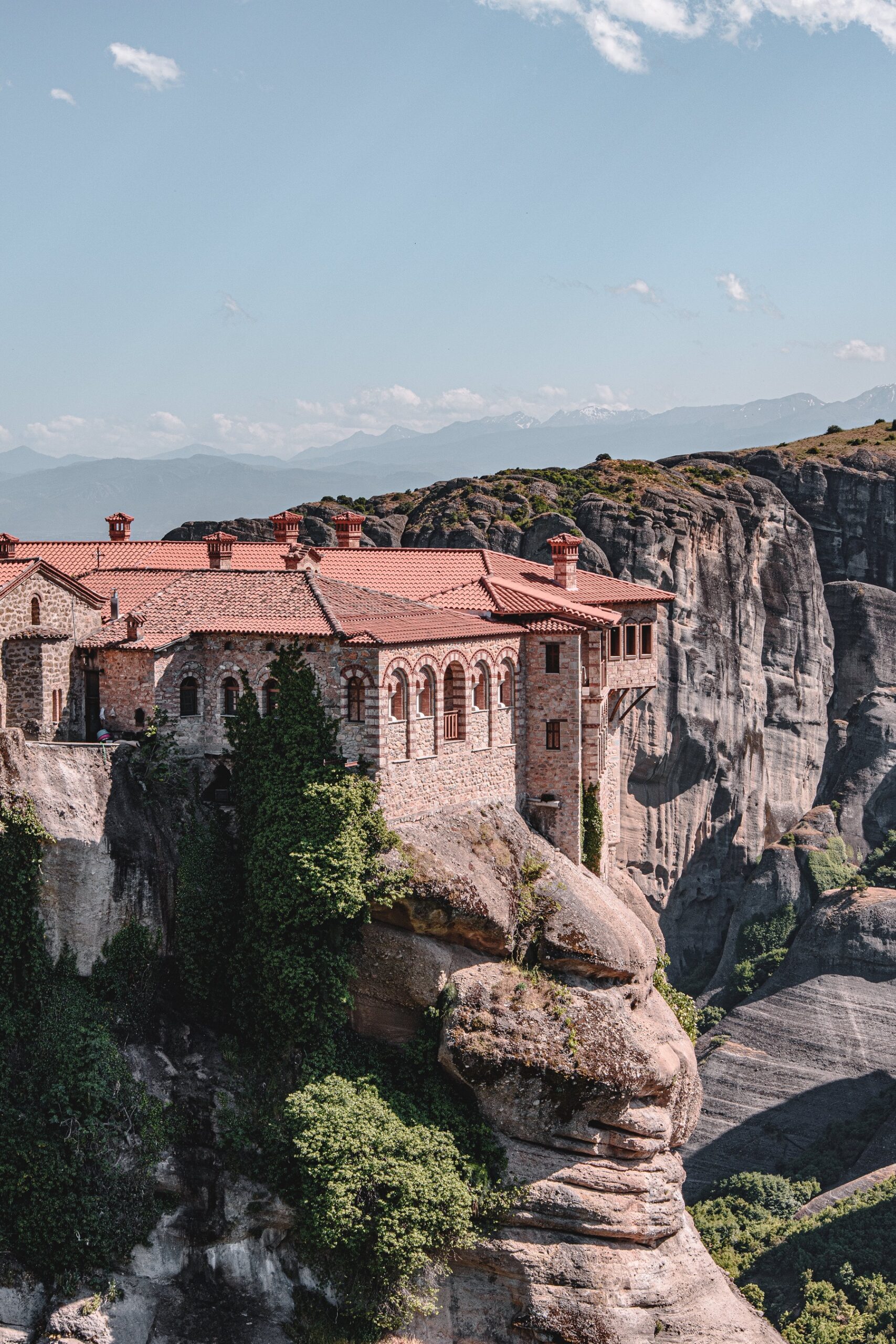
07
Kalambaka – Kastraki Hike
Total distance: 2.1 km. Time: 1 hour
The first part of this hike is a beautiful trail right at the foot of the majestic rocks of Bandova, Agia, and Amparia. In the second part, you will need to walk a little on asphalt and dirt roads, but the third and final part is also an exquisite trail in the shade of the rocks of Pyxari and Marmara. It is worth taking a small detour to visit the Monastery of Agios Nikolaos Kofinas, a large cave that has been transformed into a six-story hermitage.
More Activities in Meteora
Rock Climbing
The impressive cliffs of Meteora are a rock-climbing destination unlike any other in the world. The combination of limestone rock, stunning landscapes, and the culmination of every climbing route at the peak of these towering giants, with its spectacular views and deep cultural significance, is truly unique!
Nearly 800 climbing routes, across 15 climbing fields of all levels of difficulty, offer a one-of-a-kind climbing experience. For detailed technical information on the climbing fields of Meteora, check out the climbing guide “Sport Climbing Guide/Meteora and Theopetra” by local climber Vangelis Batsiou and “Greece Sport Climbing/The Best Of” by Aris Theodoropoulos.
For Meteora, TERRAIN has just released a detailed hiking map on a 1:12,500 scale, which depicts all the trails in the area, hostels, temples, monasteries, museums, and all the attractions with the utmost accuracy.
Rappelling
The most famous climbing spot in Meteora and an ideal destination even for beginners is the rock of Doupiani. The meeting point is usually the camping area Vrahos in Kastraki, which is loved by climbers and rappellers alike, so a short hike before the rappelling is necessary.
Following the old path of the monks and hiking among monasteries and ancient hermitages, you will reach Doupiani. After receiving the necessary training in rappelling techniques, you will make the descent with a rope of about 20 meters in length. Trekking Hellas is a well-trusted adventure tourism organization that offers rappelling experiences in Meteora.



